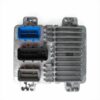The Central Command for Your Engine: Restoring Your 2006 Rainier’s Performance
The Powertrain Control Module (PCM), often called the Engine Control Module (ECM), is the electronic brain of your 2006 Buick Rainier and its robust 4.2L engine. It meticulously manages everything from fuel injection and ignition timing to transmission shifting and emissions control. When this critical component begins to fail, it can cause a cascade of confusing and frustrating problems, leaving your vehicle unreliable and performing poorly. This replacement module is the definitive solution to restore your vehicle’s factory operation and get you back on the road with confidence.
Is Your Powertrain Control Module Failing? Common Symptoms
A failing PCM can manifest in various ways, often mimicking other sensor or component failures. If you’re experiencing any of the following issues, a faulty engine computer may be the culprit. Proper diagnosis is key, but these are hallmark signs of a module reaching the end of its service life.
- ✔ Unexplained Check Engine Light: The light may be on with internal processor fault codes like P0601, P0606, or other communication-related errors.
- ✔ Engine Stalling: Your vehicle may stall for no apparent reason, either at idle or while driving.
- ✔ Rough Idling or Misfires: The engine may run poorly, shake, or feel underpowered due to incorrect fuel and spark commands.
- ✔ No-Start Condition: The engine will crank over but refuses to start, often due to the PCM not firing the injectors or ignition coils.
- ✔ Poor Fuel Economy: A sudden and significant drop in MPG can be caused by the PCM running an inefficient fuel map.
- ✔ Erratic Transmission Shifting: The PCM plays a crucial role in controlling shift points; failure can lead to harsh, delayed, or incorrect gear changes.
- ✔ Loss of Communication: A diagnostic scan tool may be unable to communicate with the PCM, a clear sign of an internal issue.
From the Diagnostic Bay
We had a 2006 Chevy Trailblazer (which shares the same platform and PCM) come into the shop with a maddening intermittent stalling problem. It would run perfectly for days, then suddenly die at a stoplight. There were no stored trouble codes. We checked the fuel pump, crank sensor, and wiring harnesses, but everything tested fine. During a long test drive with a professional data logger connected, we finally caught it in the act. Just before stalling, the 5-volt reference signal from the PCM to the sensors would drop out completely. This was a tell-tale sign of an internal PCM fault that only occurred when the unit reached a specific temperature. Replacing it with a VIN-programmed module like this one provided an immediate and permanent fix.
Why a VIN-Programmed 2006 Rainier Powertrain Module is Essential
This isn’t just an off-the-shelf part; it’s a complete, vehicle-specific solution. We program this module using the latest GM software updates and your vehicle’s unique 17-digit Vehicle Identification Number (VIN). This critical step ensures that the computer’s software perfectly matches your Buick’s specific options, including emissions systems, gear ratios, tire size, and anti-theft system. Installing a non-programmed module from a junkyard or another vehicle will result in a no-start condition and incompatibility issues. Our service eliminates the need for an expensive trip to the dealership for programming, making this a straightforward and cost-effective repair.
Installation and Required Procedures
Physically installing the module is simple. After disconnecting the battery, you can locate the PCM on the driver’s side of the engine compartment, disconnect the electrical harnesses, and unbolt the unit. However, after installation, two important electronic procedures are typically required:
- Security Relearn (Passlock/Passkey): Your vehicle’s anti-theft system must be synchronized with the new PCM. This procedure can usually be performed without special tools and involves a sequence of key cycles. Instructions are readily available online or in service manuals.
- Crankshaft Position (CASE) Relearn: This procedure synchronizes the new PCM with the crankshaft position sensor, ensuring accurate misfire detection. This requires a bi-directional scan tool and can be performed by most professional repair shops.
Guaranteed Fitment
This module is a direct replacement for part number 12594430 and is compatible with numerous other part numbers across a wide range of GM vehicles, including the Chevrolet Colorado, GMC Canyon, Hummer H3, Isuzu Ascender, and more. By providing your VIN, you guarantee that you will receive a perfectly matched and correctly programmed computer for your specific application.
Frequently Asked Questions
What is a VIN and why do you need it?
The VIN, or Vehicle Identification Number, is a unique 17-digit code for your vehicle. It’s like a fingerprint, containing information about the manufacturer, model, year, and specific equipment. We use your VIN to load the exact factory software and calibrations your vehicle requires, ensuring perfect compatibility and performance.
Is this module difficult to install?
The physical installation is straightforward for anyone with basic mechanical skills, typically taking less than 30 minutes. However, you must perform the security relearn procedure after installation for the vehicle to start. A CASE relearn may also be necessary and requires a capable scan tool.
What happens if I don’t provide my VIN?
We cannot ship the module without your VIN. The programming process is essential for the part to function in your vehicle. Please provide your VIN during checkout or send it to us in a message immediately after your purchase to avoid delays.
Will this fix my check engine light?
This module will resolve issues and check engine lights caused by an internal PCM failure (e.g., codes P0601, P0602, P0606). If your check engine light is on due to a faulty sensor or another component, you must fix that underlying issue first. This PCM will not fix a problem with a bad O2 sensor, for example.
Do I need to send my old computer back?
No, there is no core charge for this part. You can keep your old module. However, we encourage you to recycle it at a local electronics recycling facility.


